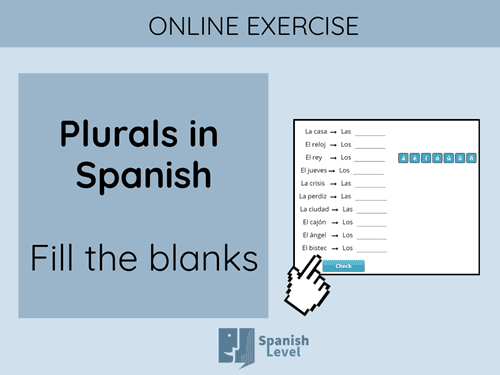In Spanish there are singular nouns and plural nouns, like in other languages. This post is about plurals in Spanish and how to form them, seeing the general rule and also the different cases where there are changes in the spelling of plural nouns.


But while English language has a single form in the definite and indefinite articles for both singular and plural (the, a, an), in Spanish we must change the articles to their plural forms:
Definite article:
la silla → las sillas
el coche → los coches
Indefinite article:
una casa → unas casas
un teléfono → unos teléfonos
How to form the plurals in Spanish
Generally, to form the plural of nouns in Spanish, we add -s or -es to word endings. We add -s if the ending of a word is a vowel and -es if the word ending is a consonant. See the following examples:
VOWEL ENDING → ADD -S
la casa → las casas
el oso → los osos
CONSONANT ENDING → ADD -ES
la ciudad → las ciudades
el ascensor → los ascensores
However, sometimes there are changes in the spelling of plural nouns in Spanish. We are going to learn the rules about how to form the plurals in Spanish depending on the ending or the noun: vowel or consonant.
Nouns ending in vowel
The writing of plurals in Spanish changes in the following cases:

casa → casas
perro → perros
bolso → bolsos

café → cafés
sofá → sofás
chalé → chalés
The names of musical notes: fa → fas, re → res, do → dos…
🔴 Exceptions:
no → noes (when it acts as a noun)
yo → yoes
Plurals of vowels a, e, o: a → aes, e → es/ees, o → oes

If they are nouns of nationalities, the ending -es is preferred, specially if it is written.
iraní → iraníes (nationality)
In most nouns ending in -í, -ú, specially colloquial nouns, you can use the -s or -es ending since both are correct, but in spoken Spanish the -e- is usually omitted, so the -s ending is more common.
esquí → esquís, esquíes
tabú → tabús, tabúes
🔴 The nouns menú and champú always form their plural with -s ending. The -es ending is not valid for these cases.
menú → menús
champú → champús
Nouns ending in consonant

ciudad → ciudades
árbol → árboles
canción → canciones
quehacer → quehaceres
marqués → marqueses
altavoz → altavoces
reloj → relojes
sándwich → sándwiches

el cómic → los cómics
el airbag → los airbags
el mamut → los mamuts

However, the plural of web is made with -s: las webs. But if say las páginas web or los sitios web we do not add the final -s in web, since it has already been added to the noun página / sitio.


While in singular we say el lápiz (the pencil), ending in Z, in plural we say los lápices (the pencils). We have changed the Z to a C. The sound of both letters is the same, but the spelling changes.

la crisis → las crisis
This rule does not apply to sustantivos agudos ending in -x:
el fax → los faxes

el lunes → los lunes
el martes → los martes
el miércoles → los miércoles
el jueves → los jueves
el viernes → los viernes

el buey → los bueyes

el espray → los espráis
This is a noun with foreign origin (spray), that has been adapted to Spanish, so we only add a final -s, not -es.

el iceberg → los icebergs

More about Spanish plural nouns
There are some more aspects to consider in relation to the plural of nouns in Spanish.
- Some nouns only have a plural form. These are called pluralia tantum. An example of this is the noun víveres (which means supplies or provisions).
- Some nouns only have a singular form. These are called singularia tantum. An example of this is the word sed (which means thirst).
- Nouns referred to objects made of two symmetrical parts may be in singular or plural, this does not matter because both refer to a single object:
la tijera = las tijeras (both refer to a single object).
la tenaza = las tenazas (both refer to a single object). - Some nouns always use a plural form to refer to a single object; e.g. las gafas
